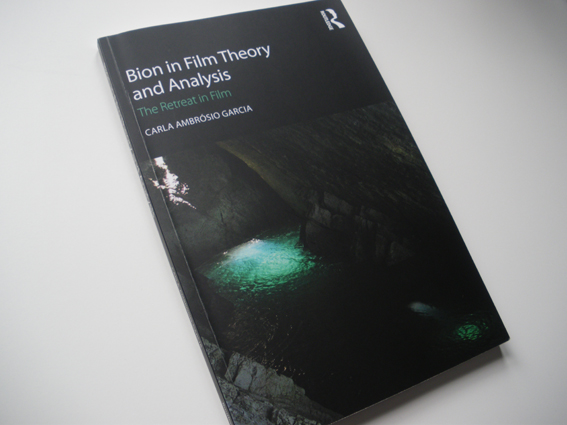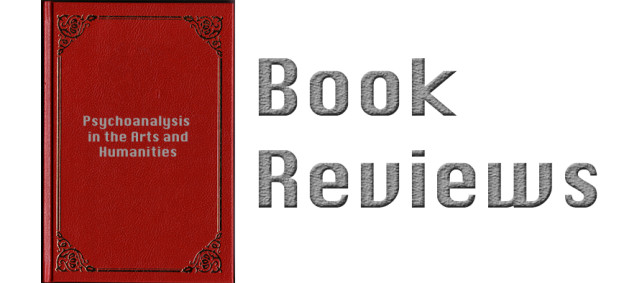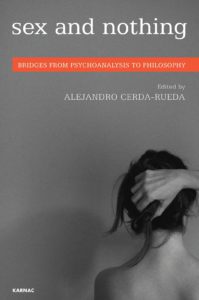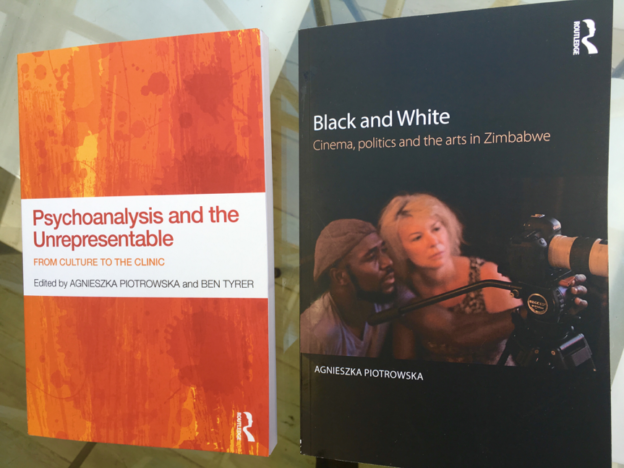By Carla Ambrósio Garcia
Bion in Film Theory and Analysis: The Retreat in Film is a book published by Routledge that was launched earlier this year at the Close-Up Film Centre in London, alongside the premiere of the film Sea Cave Cinema. This book and this film are two forms of research that originated in the same question: what if Plato’s forms could be found inside the cave? Since then, these two objects of research developed in their own way, yet always maintained a kind of dialogue between them, even if this was not explicitly acknowledged. What follows is intended to go some way towards making that dialogue more tangible.
The project began when I encountered images of a cave located near Sesimbra in Portugal, which, because of its difficult access, was only discovered in the mid-1990s.. The cave’s formations, in vivid colours and various textures, had strange, evocative shapes that led me to ask: what if these were the true forms of the objects in the outside world that they seemed to evoke? There was a sense of wonderment and discovery in the contemplation of these images, and this made me think of an inversion of Plato’s allegory of the cave, whereby Plato’s forms could be found inside the cave and could be perceived by the senses.
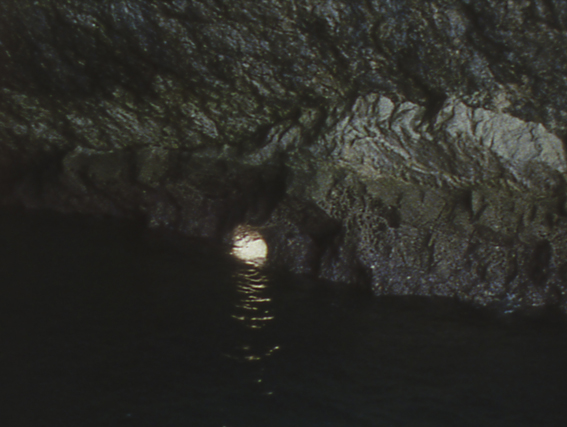
A still image from SEA CAVE CINEMA
While Plato was interested in the movement from inside to outside the cave – from what he postulated was a place of illusions to a space where the true forms of things could be apprehended through the intellect – I was thinking of the opposite movement, and of a different topography. Implicit in this movement of ‘going back into the cave’ was a gesture of retreat from the ‘outside world’. But this gesture, to my mind, did not simply imply a regression or a mere return to an origin.
Plato’s cave has been used to theorize the cinema numerous times, perhaps most famously by the French film theorist Jean-Louis Baudry (1975). Wanting to see how I could challenge this analogy, I began to think about the cinema as a potential space of transformation and discovery, and to see it through a psychoanalytical lens, as a space connected with the internal world.
At this point the work of the British psychoanalyst Wilfred Bion came into the project. Bion, reader of Plato, Kant, and other philosophers, was also concerned with forms, noumena, ultimate reality. He considered what happened between analyst and analysand in the consulting room to be unknowable, a thing-in-itself in Kant’s sense – what Bion called ‘O’ – as it was always subject to transformations in the mind of the people involved (Bion, 1965). These transformations deserved investigation if we were to better understand what psychoanalysis is or could be.
If Bion was interested in the notion of an ultimate reality beyond our apprehension, he conceived of emotions in a very different way to how Plato saw them. Plato saw emotions as ‘the lower elements in the mind’, opposed to reason (Plato and Lee, 1955, p. 348), whereas for Bion the growth of the mind is in fact dependent on the capacity to think about emotions. The mind grows as it becomes able to assimilate emotional experiences; and the mother’s role in containing and assimilating the infant’s emotions through communicative projective identification is fundamental in the initial stages of this process (Bion, 1961). In later formulations of his theory of thinking, Bion notes that it is not the apprehension of the ultimately real that is stake; rather, it is the capacity to be or become real, which entails the process of being or becoming at one with our own emotional truth.
Parallel to this reading and writing about Bion’s theory of thinking and how it was helping me to rethink the experience of the subject in the cinema, I contacted the speleology group who had discovered the cave I had seen in pictures. The NECA group (Núcleo de Espeleologia da Costa Azul) first showed me some other caves they knew in the area, and it was, in the end, in one of these caves that I decided to make a film. This was a sea cave with a hole in its ceiling, which at a certain time of the day projected a beam of sunlight on the undulating surface of the sea, which in turn projected a moving image of light on the cave wall.
There was something cinematic about this cave. In a way, it was already a cinema. What could my experience of being a spectator of its moving images, of making a film from these images, and of thinking about how to present the film to an audience, tell me about the experience of cinema? What could this film tell us about cinema?
As I filmed inside the cave and the day passed, I saw the light of the Sun being transformed. I also saw the waves become bigger, and the tide begin to ebb, and was reminded of the gravitational force of the Moon. Things were projected and contained inside containers, which then became contained in other containers, such as my eyes or my camera. The coming together of these things produced transformations: different shapes of light and water, different sounds, slow erosions, exposures, and emotions.
I was rethinking the cinematic apparatus with Bion, but I did not want to confine my theory to the space of the cinema. In my view, cinema can happen in other spaces or situations too, but what is it that defines those spaces or situations? What, when, where is cinema? What, when, where is the retreat in cinema? I decided to shoot a last roll of film somewhere outside the cave, perhaps at night, on the coast. I was not sure what I was looking for, but I needed a place to set up my camera. As I walked along the shore, I saw the reflection of the Moon on the water that filled a small hole in the rock. I aligned my camera with the Moon and this tiny reflection, and let the film run. The two long takes that make up this roll are the opening shots of Sea Cave Cinema. The spot of light in the rock gradually disappears in the second shot, as the Earth and the Moon continue along their course. Then, the film cuts to an image inside the cave, filled with bright reflected light.
During the process of making Sea Cave Cinema I realised that it is about a force, an energy between things that move, when they become temporarily placed in relation to each other. The different elements that compose the spaces in the film – the sunlight, the moonlight, the cave, the water, the wind, the waves – seem to come together in certain patterns, in relations that involve a force, a tension, an attraction, and then let go. Cyclical, linear, chaotic – day after day, season after season, through the years. These energetic fields carry with them visible and invisible areas, sounds and silence, sensations, effects, and affects. They make things strikingly visible and audible, or barely perceptible, and then plunge them again in darkness and silence, drown them into horizons, to then return.
Pluto and its moon Charon rotate and revolve around each other in tidal locking. This means that they always show the same hemisphere to each other as they move; in other words, they always face each other as they move. Because Earth’s mass is bigger than the Moon, only the Moon is tidally locked to the Earth. The Moon always faces us, but we turn away from it, only to return again after some time.
The cinema is a massive circulation of images happening around the world in certain patterns, and we are attracted to it also in patterns, aligning ourselves with its energies, at certain moments in time.
Sea Cave Cinema is about how we make space and time for cinema. I made the film on 16mm film, and showed it in a darkened space. I wanted an encounter with space and time for cinema, at a time when our encounter with digital images is so pervasive that most have become completely banal or indistinct. I wanted this film to be seen very much as belonging to this moment in the history of cinema, even though it was made using technologies that have been around for decades, and shown in a space that has existed for even longer, for the experience of film. To paraphrase one of Bion’s comments on the suppression and expression of the epistemophilic instinct (1965, p. 77), I do not see these choices as backward-looking, having been made in relation to what might have been lost, but instead as forward-looking, searching for what can be found.
The image I found in this work is not of a specific or ideal form of cinema; it is an image of a relation, an encounter, a certain energy or force, an effort even, a focused experience. This encounter has a certain physical and psychical quality about it, but it is one that can take many forms.
Bion in Film Theory and Analysis: The Retreat in Film looks at some of the forms of this encounter: experiences of unpleasure, pain, turbulent moments of psychical change: film’s thoughts in search of a thinker. Within the object-relations paradigm in psychoanalysis, Bion notes the importance of the metabolizing function of the container – mother, analyst, an other – for the development of our own capacity to think. However, a certain energy or effort in that process has to be allowed to take space and to take time. Cinema is about this encounter with ourselves and with others at a deeper level: it is about objects, and about subjects, put in relation. The work of Bion and object-relations psychoanalysis are of crucial relevance to our study of the cinema and its transformations.
References
Ambrósio Garcia, C. (2017). Bion in Film Theory and Analysis: The Retreat in Film. Abingdon, Oxon; New York, NY: Routledge.
Baudry, J-L. (1975). The apparatus: Metapsychological approaches to the impression of reality in the cinema. In: Rosen, P. (ed.) Narrative, Apparatus, Ideology: A Film Theory Reader. New York: Columbia University Press, 1986.
Bion, W.R. (1961). A theory of thinking. In: Second Thoughts: Selected Papers on Psychoanalysis. London: Karnac, 2007.
Bion, W.R. (1965). Transformations. London: Karnac, 1984.
Plato and Lee, D. (1955). The Republic. Translated by D. Lee. London: Penguin, 2003.
Filmography
Ambrósio Garcia, C. (2017). Sea Cave Cinema. 16mm colour film, 16 min.

